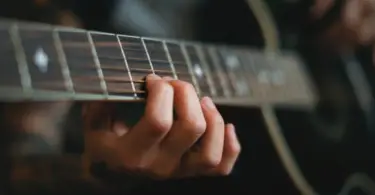Purchasing electric guitar strings can seem to be a difficult task. Many players become confused and uncertain which strings may be best for them, due to the overwhelming selection available. Strings are essential for playing the guitar, so it’s important to choose the best strings.
While there is no universal “best” type of guitar string, I’ve put together this primer to help choose the best options based on a number of factors. Playing style, musical genre, tuning, and other variables can all help determine which strings are the best fit. A guitar player should consider playability, tone, and durability when selecting strings.
I have played guitar for many years, but I remember facing the challenge of finding the best strings for me. I tried numerous brands and different gauges within each brand. I have tried different string materials as well as different types of windings.
I researched types of strings, asked fellow musicians for their opinions, and tested strings until I found the strings that I liked best. I hope that sharing my knowledge and experience can help other players more easily find their preferred strings.
Guitar String Features
With so many different strings on the market, it is wise to review the basic characteristics that all strings have. The specific characteristics of a certain set of strings can help to determine if those strings are a good choice. The main characteristics of electric guitar strings are string gauge, string material, and winding type.
String Gauge
The gauge of an electric guitar string is its diameter (or thickness), and is usually measured in thousandths of an inch. The thinnest strings produce the highest notes and the thickest produce the lowest notes. Each string in a string set will be of a different gauge, but guitarists usually refer to a set of strings by the thinnest string. If the thinnest string in a set measures .009 inches, that set is commonly referred to as a set of “9s.”
Electric guitar strings are available in many gauges, but they are generally sold in sets designed to have a balanced feel. While exact gauges and set names vary by manufacturer, the six most common gauge sets are
- Extra light: .008, .010, .015, .021, .030, .038
- Light: .009, .011, .016, .024, .032, .042
- Regular: .010, .013, .017, .026, .036, .046
- Medium: .011, .015, .018, .026, .036, .050
- Heavy: .012, .016, .020, .032, .042, .054
- Extra heavy: .013, .017, .026, .036, .046, .056.
Extra Light Strings
While there are smaller gauge sets, extra light is the smallest gauge commonly available. Guitarists usually consider lighter strings to be easier to play. While this is generally true, I do not think this opinion is true of extra light strings. They are quite easy to play, but they are so thin that a very light touch is needed.
Many players may unintentionally bend a note sharp just from finger pressure while fretting. These strings will tend to be brighter and more prone to breakage than heavier gauges.
If speed is a major component of a guitarist’s playing style, this gauge is worth considering. With a low action on the guitar, the extra light gauge can definitely help make fretting and bending much easier. Tony Iommi of Black Sabbath prefers this string gauge.
Light Strings
Light gauge strings are among the most commonly used strings. They generally have a brighter tone and are easier to play. Light strings allow for easy bending and fretting, but do not require as light a touch as extra light strings do. This gauge is a good choice for any musical genre that includes lead guitar playing. Eddie Van Halen uses a custom set of light gauge strings.
Light strings are also a good choice for beginning guitarists. The reduced effort needed for fretting allows beginners to practice longer without hand fatigue. I prefer light gauge strings on most of my guitars.
Regular Strings
The next string gauge is slightly heavier, generally referred to as “10s.” This gauge is very common among rock guitarists. The slight increase in size provides a warmer tone than the lighter gauges while still being easy to play. Some players prefer regular strings specifically because these strings offer a bit more resistance, allowing more control.
Many rock and blues players like using regular gauge strings, as they perceive the thicker strings to have a fuller sound than the lighter gauges. Regular gauge strings are the preference of Eric Clapton and many other guitarists.
Medium Strings
While not as common as light and regular strings, medium gauge strings are used by a number of rock and blues guitarists. This size is not a good choice for beginners, but may be a suitable choice for players that have developed the hand strength needed to bend and fret these strings well.
These strings have a warm tone and greater sustain than the lighter gauges. Slash uses medium gauge strings.
Heavy and Extra Heavy Strings
The heavy and extra heavy gauges are the largest in diameter. While not easy to bend or fret, they deliver the warmest tone and a louder, fuller sound. The heavy string gauge is a good choice for heavy rhythm players such as Malcolm Young of AC/DC.
Extra heavy strings are becoming more frequently used by metal guitarists, as their rigidity allows for down-tuning while still retaining adequate string tension. Some non-metal guitarists choose the extra heavy gauge (or even larger) for the greatly increased warmth and volume. Extra heavy string players include Stevie Ray Vaughan (13s) and Dick Dale (16s).
Determining which string gauge is best is entirely dependent upon the player. Guitarists should try different gauges to determine which gauge best fits their playing styles and abilities. In general, lighter string gauges are easier to play, although they do deliver less sustain and volume. They are a good choice for beginners.
Heavier gauge strings are a bit more difficult to play, but they deliver greater sustain and volume. They are best for experienced players and those using low tunings.
Custom
Although I did not cover them in this article, there are a number of custom or hybrid string sets available. Those sets may be a possible option for those players looking for something different from the norm.
String Material
Generally, the smallest three strings in a set are made of plain steel, while the larger three strings are constructed of a steel core with a metal wrap, or winding. Some exceptions may be found, such as the wound third string in most extra heavy gauge sets.
The different metals used in the windings can affect the tone, playability, and durability of the strings. Some strings also have a coating on the winding.
Nickel-Plated Steel
Nickel-plated steel strings are the most common electric guitar strings. They deliver the volume and bright tone for which steel strings are known. The nickel plating adds the benefits of reduced finger noise, resistance to corrosion, and finger comfort. This type of string is more durable than most other types.
Stainless Steel
Stainless steel strings are built with a steel core and a stainless steel winding. The winding does not have a coating or plating. Stainless steel strings produce considerably more volume and a much brighter tone than other types of strings do, but these strings have some drawbacks.
Stainless steel strings tend to lose their brightness more quickly than other types of strings, and many players feel these strings are harder on the fingers. The sound of finger movement along these strings is also more pronounced than on other types of strings.
I like the sound of stainless steel strings, even after they have lost some of the initial brightness. I don’t find them to be harder to play. I would encourage all guitarists to give them a try.
Nickel
Pure nickel strings are often the choice of players who want a vintage tone. Most electric guitar strings were made of nickel in the 1950s and 1960s. Nickel strings offer a smoother, warmer tone.
They are softer than other strings, which makes them easier to play but also makes them more prone to breakage. Many jazz and blues players prefer the warm sound of nickel strings.
Polymer-Coated
In the 1990s, a new process was developed to coat guitar strings. A polymer such as Teflon is used to seal the string, making the surface of the string smoother while also protecting the string from corrosion. Some guitarists find polymer-coated strings to be slippery, leading to difficulty bending notes.
These strings also have less sustain than other types of strings. Coated strings are usually more expensive than other strings. This higher cost may be offset by the reduced need to change strings.
I don’t feel most players need to use coated strings, but I do think they can be of great benefit to some players. I know some guitarists who have very acidic sweat. One playing session results in corroded strings and a necessary string change. For such players, coated strings are a bargain even at the higher cost.
Other Materials
Other materials used to make guitar strings include chrome, cobalt, titanium, gold, bronze, and even plastic. Gold-plated strings are an excellent choice for players who suffer from an allergy to nickel.
Bronze strings are commonly used on acoustic guitars, but should not be used on electric guitars. Due to the electromagnetic properties of bronze, the sound of these strings will not be properly carried by electric guitar pickups.
Some players may find these string materials to be noticeably different, while others may find most of them quite similar. The best way to decide which material is best for you is to try as many as possible.
String Winding
The type of winding used on an electric guitar string can significantly affect both the tone and playability of the string. In most string sets, the three thickest strings are wound, consisting of a metal core wire around which is wrapped another metal wire.
The three thinnest strings are usually unwound wire, although it is not uncommon for the third thinnest string to be wound in heavier string gauges. The three common types of winding are roundwound, flatwound, and halfwound.
Electric guitar strings also include two different core types, round and hex. The core is the inner wire around which the winding is wrapped.
Core Types
Hex core strings have a hexagonal inner wire. This type of core allows the winding to be more tightly wrapped. The edges of the core wire prevent the winding from slipping. The use of a hexagonal core wire will produce a string that lasts longer and has greater tuning stability.
However, hex core strings are more rigid than round core strings and may not be the best choice for players whose styles involve lots of bending.
Round core strings were once the guitar string industry standard. As the name suggests, this core wire is round. The round shape allows for increased contact between the core and the winding, resulting in a warmer tone.
These strings are also more flexible, making them a great choice for players who love bending notes. It has become more difficult to find round core strings, but there are manufacturers who still make them.
Roundwound Strings
Roundwound strings are the most common electric guitar strings. They are made by wrapping a round outer wire around a round or hexagonal core wire. Roundwound strings produce a brighter tone than strings with different winding types.
Despite their popularity, roundwound strings have some negatives. The round winding produces a ridged surface on the string, resulting in “finger squeak,” the sound made as the player’s finger rubs against these ridges while moving along the string. The rougher surface of a roundwound string also causes greater fret wear than other strings.
Flatwound Strings
Flatwound strings are constructed by wrapping a flat ribbon-like wire around a round or hexagonal core wire. Flatwound strings have a warmer and more mellow tone than roundwound strings. Although some rock guitarists might consider this tone to be lifeless, many jazz players prefer flatwound strings due to this smoother tone.
Finger noise is low with flatwound strings due to the lack of ridges. The lack of ridges also contributes to flatwound strings causing less fret wear than roundwound strings. Flatwound strings may also last longer because they have smaller grooves for dirt and skin oils to accumulate in.
Halfwound Strings
Halfwound strings are a compromise between roundwound and flatwound strings. They are sometimes called groundwound strings due to the manufacturing process used to make them. Halfwound strings begin as roundwound strings that are then ground and polished until the string is almost flat.
This process produces a string that feels like a flatwound string but has a brightness between a flatwound and a roundwound. Flatwound strings can be more difficult to find and are usually more expensive, due to the more complicated manufacturing process.
The Competition
After hours of testing and research, here's the final competition.
| Instrument | Rating | Current Pricing |
|---|---|---|
Ernie Ball | known to manufacture long-lasting, high-quality strings at a reasonable price |  |
D’Addario | produces an incredible range of strings |  |
GHS | strings produce a bright tone and excellent sustain |  |
Elixir | makes a polymer coated string that is far more durable than plastic-coated |  |
Fender | Bullet-end strings with greater sustain and better tuning stability than ball-end strings |  |
My Recommendations
Electric guitar strings have so many variables that it is impossible to choose a particular “best” string for even one type of guitar player, let alone for all guitarists in general. Instead of recommending one best choice, I have opted to review several of the most popular brands of strings.
With the knowledge of these brands and some of their offerings, you will have a good starting point for your own research and experimentation with various types of strings.
Ernie Ball

Credit: Ernie Ball Inc
Ernie Ball is one of the most popular electric guitar string companies in the world. Frustrated by the limited selection of string gauges available, company founder Ernie Ball began producing custom sets of strings in 1962. This innovation provided guitar players with access to lighter gauges than were typical at that time. Ernie Ball is known to manufacture long-lasting, high-quality strings that can be purchased at a reasonable price.
Ernie Ball strings are used by many well-known players, including Eric Clapton, Jimmy Page, Jeff Beck, Slash, Brad Paisley, and many others. These strings are the choice of bands such as Metallica and Iron Maiden. After trying many brands, I also found Ernie Ball strings to be my favorite.
Ernie Ball makes many different sets of strings, but its most popular sets are the Super Slinky (9s) and Regular Slinky (10s) sets. The Super Slinky set is a great choice for players ranging from beginners to shredders. The Regular Slinky set will work well for rock, blues, and country players. My primary strings are Ernie Ball Stainless Steel Super Slinky. I also use the nickel-plated Regular Slinky on one guitar.
No matter which Ernie Ball set you choose, they are always affordable, with prices usually starting around $5.00. Ernie Ball also produces a “Tone Pack” that allows you to try its original, cobalt, and M-steel versions of Regular Slinky or Super Slinky strings for $20-25.
D’Addario

Credit: D’Addario & Co
Although the modern company that bears its name has only existed since 1974, the D’Addario family has included string making among its professions since 1680. Although the family originated from Italy, D’Addario strings are made in America, at a factory in Farmingdale, NY. The company also makes strings for bass and acoustic guitar, but its XL series electric guitar strings are its most popular product.
D’Addario strings are used by many players in various genres, including Al Di Meola, Pat Metheny, Vince Gill, Ben Harper, Joe Satriani, and many others.
The EXL110 is D’Addario’s best-selling string set. It is a set of roundwound nickel-plated strings in what the company calls “regular light” gauge (.010-.046). D’Addario produces an incredible range of strings. I think any player should be able to find a D’Addario string set that is a great choice. The selection of hybrid sets is unmatched, providing a number of options combining lighter strings and heavier strings.
Considering D’Addarios solid reputation and high-quality strings, its products are surprisingly affordable. Prices for singles sets start at approximately $4.00, with multi-pack sets averaging even less per pack. D’Addario proves that high quality does not need to come with a high price, and I recommend all players to try this company’s strings.
GHS

Credit: Amazon.com
GHS is unusual for a string company, in that it still uses a round core for the majority of its strings. The most popular GHS string type is the nickel-plated roundwound Boomers, which produce a bright tone and excellent sustain. GHS has produced roundwound strings for over 40 years, and that experience is reflected in the high quality of its products.
While not as well-known as some other brands, GHS makes the strings of choice for famous guitarists such as David Gilmour, Ted Nugent, and Warren Haynes, as well as bands such as Soundgarden, the Moody Blues, and the Trans-Siberian Orchestra.
GHS strings are inexpensive, making GHS Boomers the obvious choice for any player wishing to try roundwound strings. Prices start at just under $4.00.
Elixir

Credit: Amazon.com
Elixir drove guitar string manufacturing technology forward in the 1990s with its newly-developed string-coating processes. Elixir wasn’t the first company to produce coated strings, but its offerings were a huge improvement over the earlier products. Using its new POLYWEB and NANOWEB coating technology, Elixir makes a coated string that is far better than the plastic-coated strings that preceded it.
Elixir’s string coating envelops the string in a polymer, protecting the string from dirt, skin oils, and corrosion. For players whose acidic sweat can destroy a set of strings in one day, Elixir strings can be a godsend. The higher cost of the Elixir strings is easily offset by the reduced need for new strings.
Elixir’s two different coatings produce strings with different characteristics. Strings with the original POLYWEB coating have a warmer tone, while strings with the NANOWEB coating are much brighter.
Elixir strings are the favored strings for players such as Johnny Hiland and Wayne Sermon, lead guitarist for Imagine Dragons.
Some players complain that coated strings have reduced sustain and too slippery a surface. Even if that is true, Elixir strings may still be a great choice for players who require a corrosion-resistant string. Another downside is that Elixir only produces a very limited selection of gauges. These strings are also fairly expensive, with prices starting around $9.00.
Fender

Credit: Amazon.com
Fender is one of the most well-known brands in all guitar-related industries. In addition to producing many classic guitars and amplifiers, Fender makes a wide range of electric guitar strings. Fender guitar strings can be used on most electric guitars, not just those made by Fender.
One of the most interesting features of Fender electric guitar strings are the “bullet” ends. Fender guitar uses bullet-shaped pieces on the bridge end of their strings instead of the more common “ball” end used by most string companies.
It is claimed that these bullet-end strings have greater sustain and better tuning stability due to the greater string contact with the bridge than is found in ball-end strings. Some Fender strings are also available with ball ends.
Not surprisingly, Fender strings are used by many players. Neoclassical shredder Yngwie Malmsteen has a custom signature set, designed for speed, playability, tone, and sustain.
Fender is a mainstay in the guitar world, and I think every player should try its strings. Fender electric guitar strings are inexpensive, with most string sets starting around $4.00-5.00. The Yngwie Malmsteen Signature strings sell for approximately $7.00.
There are many other string brands, including Gibson, DR Strings, Dean Markley, Rotosound, and Cleartone. I recommend beginners try a new string brand or type at every string change until they find the best strings for their playing styles.
Experienced players should also step outside their comfort zones when purchasing strings, for they might find a better string than the usual. Strings are quite inexpensive compared to many other things we buy as guitarists, so the cost of experimentation is fairly low.
Sources:
- Mason Hoberg, “Strings And Things: A Guitar String Buyer’s Guide,” Equipboard, August 7, 2015.
- “How to Choose Electric Guitar Strings,” The Vault, September 17, 2015.
- “Professor’s FAQs & Facts,” Professor String.
- John Wunsch, “Choosing Strings for the Best Electric Guitar Experience,” Guitar Tricks, May 1, 2015.








Start the discussion at talk.hearthemusicplay.com